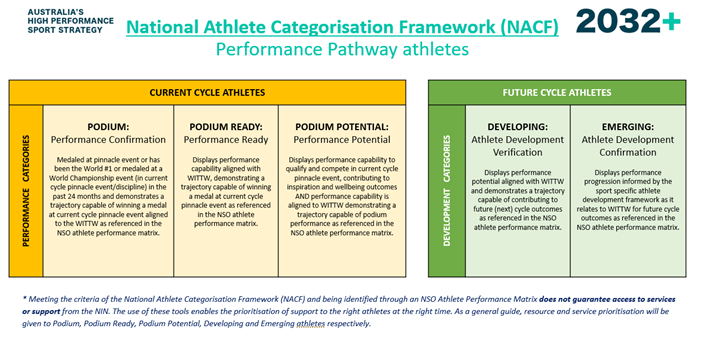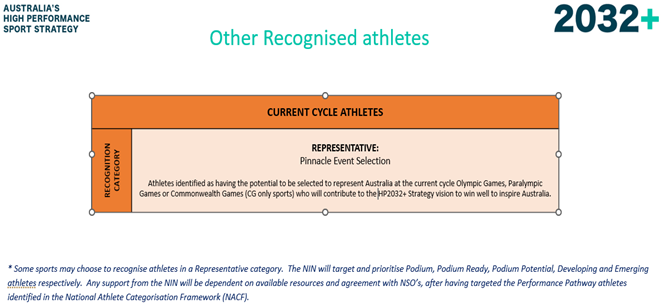LA2028 Key Framework Updates
Overview
Two key Horizon 1 activities of the HP 2032+ Strategy were to review and update both the National Sport Categorisation Framework and the National Athlete Categorisation framework for the LA2028 cycle. Both activities were undertaken through collaboration and consultation with the High Performance Sport System (HP System), including the formation of an Advisory Group, to provide advice to the AIS.
Both will come into effect for the LA2028 Cycle.
National Sports Eligibility Framework
From the start of the LA2028 cycle, a new National Sports Eligibility Framework (NSEF) will replace the current National Sports Categorisation Framework. The NSEF will outline the requirements that National Sporting Organisations (NSOs) will have to meet to be considered for support by High Performance (HP) system partners, including the National Institute Network (NIN).
The new framework is the result of a collaborative and consultative review undertaken as part of Horizon 1 of Australia’s High Performance 2032+ Sports Strategy (HP 2032+ Strategy).
A special purpose Advisory Group, comprising of representatives from HP system partners, was established to provide guidance, direction, and to develop solutions and plans around a future approach to sports categorisation.
The Advisory Group’s recommendation was that the existing National Sport Categorisation Framework should evolve into a National Sports Eligibility Framework. These recommendations have subsequently been endorsed by the HP 2032+ Strategy Horizon 1 Leadership Group, the NIN Directors, and the Australian Sports Commission (ASC) Board.
The key principle of the new approach is that NSOs will not be categorised at an initial phase based on historical results. Eligibility will instead be based on forward looking criteria and once a sport is determined to be eligible for support, system partners, including the NIN, will have the autonomy to support with investment and/or resources based on their Investment Frameworks.
Under the new framework, National Sports Eligibility will be determined by:
- The organisation being an ASC recognised sport
- The organisations being recognised as the National Federation for that sport by the Australian Olympic Committee, Paralympic Committee, or Commonwealth Games Australia for the current (or future) cycle Pinnacle Event
- The organisation has a clear High Performance Strategy, that is informed by a What It Takes To Win (WITTW) and demonstrates the ability to contribute to the outcomes of the HP 2032+ Strategy
The process will be used to inform the eligibility of sports for the LA2028 cycle. See the FAQs below for more information.
Refreshed National Athlete Categorisation Framework
Following a review as part of Horizon 1 of the HP 2032+ Strategy, the National Athlete Categorisation Framework (NACF) has been refreshed for the LA2028 cycle and beyond.
The updated NACF will provide NSOs with a consistent framework to build their sport specific processes to identify athletes with the greatest potential to contribute to Australia winning medals consistently and to continually improve Australia’s standing at current and future Pinnacle Events.
The NACF supports the united ambitions of the HP 2032+ Strategy, including:
- Identifying athletes genuinely on a pathway towards podium and providing options and flexibility to support varied athlete journeys and outliers
- Recognising that as athletes aspire to Win Well, it is through their unique journeys and stories that they inspire future generations of athletes, communities, and Australians
Following extensive consultation with HP system partners, the critical change to the Framework is an elevated focus on performance potential criteria when categorising athletes at a sport level. There will be a greater reliance on the NSO evidence informed What it Takes to Win (WITTW) and Athlete Development Frameworks (ADF) to ensure all athlete categorisation decisions are supported by evidence. The changes provide an opportunity for the system to focus on athletes who demonstrate a trajectory to podium success at the Pinnacle Event.
To support the HP2032+ Strategy vision, ‘We Win Well to Inspire Australians’, NSO’s will also have the option to recognise athletes who have been identified as having the potential to be selected to represent Australia for the current cycle Pinnacle Event as Representative Athletes.


FAQs
What are the main changes?
- The introduction of ‘National Sports Eligibility Framework’ and the removal of ‘National Sports Categorisation Framework’ and the three (3) levels of Foundation, Prospective and National.
- The key principle supporting the new approach is the recognition of a combination of HP system agreed frameworks and the ability to have organisational autonomy when determining who is eligible for support, why they are eligible and how decisions will be made to determine how much.
- The HP System have agreed the following frameworks:
- The National Sport Eligibility Framework – determines the WHO – which sports are eligible for HP system support.
- The Planning, Monitoring and Review process determines WHY – evidence informed planning demonstrated why a sport should be supported by the HP system.
- Organisation autonomy is provided in these areas:
- The organisational principles and strategic frameworks of the individual NIN determines HOW they support sport.
- The individual NIN investment & service prioritisation frameworks determine HOW MUCH support may be offered.
What is National Sports Eligibility?
- It is a system-wide approach to determining National Sporting Organisation (NSO) High Performance Sports eligibility for HP System support and resourcing.
- It confirms an NSOs eligibility (or ineligibility) to be considered for HP System support and resourcing.
- It does not confirm what, if any, level of support and resourcing this may be. That will be up to the individual organisation within their jurisdiction.
What are the key principles of National Sport Eligibility?
- The National Sport Eligibility includes the recognition of a combination of HP system agreed frameworks and the ability to have organisational autonomy when determining who is eligible for support, why they are eligible and how decisions will be made to determine how much.
- The National Sport Eligibility Framework operates at the NSO level. It does not consider individual sport, program, discipline or events. These are part of the why, how and how much considerations (see – what are the main changes?).
- It is aligned to HP2032+ Sport Strategy Pinnacle Events, with each NSO only have one Pinnacle Event
- It is designed to be objective and straightforward, while also being flexible and agile to address new or emerging opportunities.
If our NSO is eligible, how does resourcing work?
- Each National Institute Network partner has organisational autonomy (see – what are the main changes?).
- The organisational principles and strategy frameworks of the individual NIN organisation will determine how the individual NIN organisations will support sport.
- The organisational investment and service prioritisation frameworks of the individual NIN organisation will determine how much financial and non-financial support the individual NIN organisation will provide to each sport.
If each NIN has organisational autonomy, what is the system aligned on?
- Each NIN will be aligned with who is eligible and why they are eligible (see – what are the main changes?).
When do the NIN consider resourcing?
- The Australian Institute of Sport has released its LA2028+ HP Planning process which includes the milestones for engaging with the AIS and system partners – formally commencing in March 2024. The planning process is closely aligned to the HP Sport Investment Framework. NSOs will receive an indicative figure in June 2024, that will be confirmed by the end of 2024.
- The Australian Institute of Sport also operates camp-based programs and national centre of excellence programs for individual sports. The prioritisation of performance support and facility access will be conducted upon the AIS’s own internal prioritisation processes which will be developed and communicated for implementation in the LA2028 cycle.
- The State Academy of Sports and State Institute of Sports will typically consider resourcing every four years in line with summer Olympic and Paralympic Games cycles.
- Conversations with State Academy of Sports and State Institute of Sports will typically commence towards the end of year three (3) of a cycle (the year before the Olympics/Paralympics) and continue until the end of year four (4) following Games delivery.
When will this be implemented?
- Sports Eligibility will commence after the 2024 Olympic & Paralympic Games in Paris. It will, however, be incorporated within the LA2028+ Planning Process which has already commenced.
When will sports be reviewed against the National Sport Eligibility framework?
- National Sports Eligibility is a continuous and real-time framework. Sports are required to meet all four criteria areas to be eligible and remain eligible. If at a point in time, an eligible sport does not meet one criteria aspect, then they may be deemed ineligible which could impact their access to support from the NIN.
How long will the National Sports Eligibility Framework be in place for?
- The National Sport Eligibility framework will be in place for the existence of Australia’s High Performance Sport Strategy 2032+, but maybe reviewed post the LA2028 and Brisbane2032 cycles.
How did the Categorisation Advisory Panel work?
- Expressions of Interest were called for the Categorisation Advisory Group, along with 12 other HP2032+ Working Groups in April 2023. The Categorisation Advisory Group met seven times to discuss Sports Categorisation and Athlete Categorisation. The group consisted of Dave Crosbee, Sheila Galloway, Andrew Pratley, Tim Matthews, Simon Cain, Peter Kyffin, Nicola Johnson and Robin O’Neill. The group was supported ASC staff who provided ground work based upon their discussions.
How do I be recognised as an ASC Sport?
- The ASC periodically reviews and updates the recognition criteria and supporting process to ensure each remains relevant and contemporary. For more information, please contact recognition@ausport.gov.au
How do I know if I’m a recognised National Federation by the AOC, PA or CGA?
- Each organisation will make a determination around which organisation is recognised as the member National Federation for a sport in Australia. For more information, please contact the relevant body.